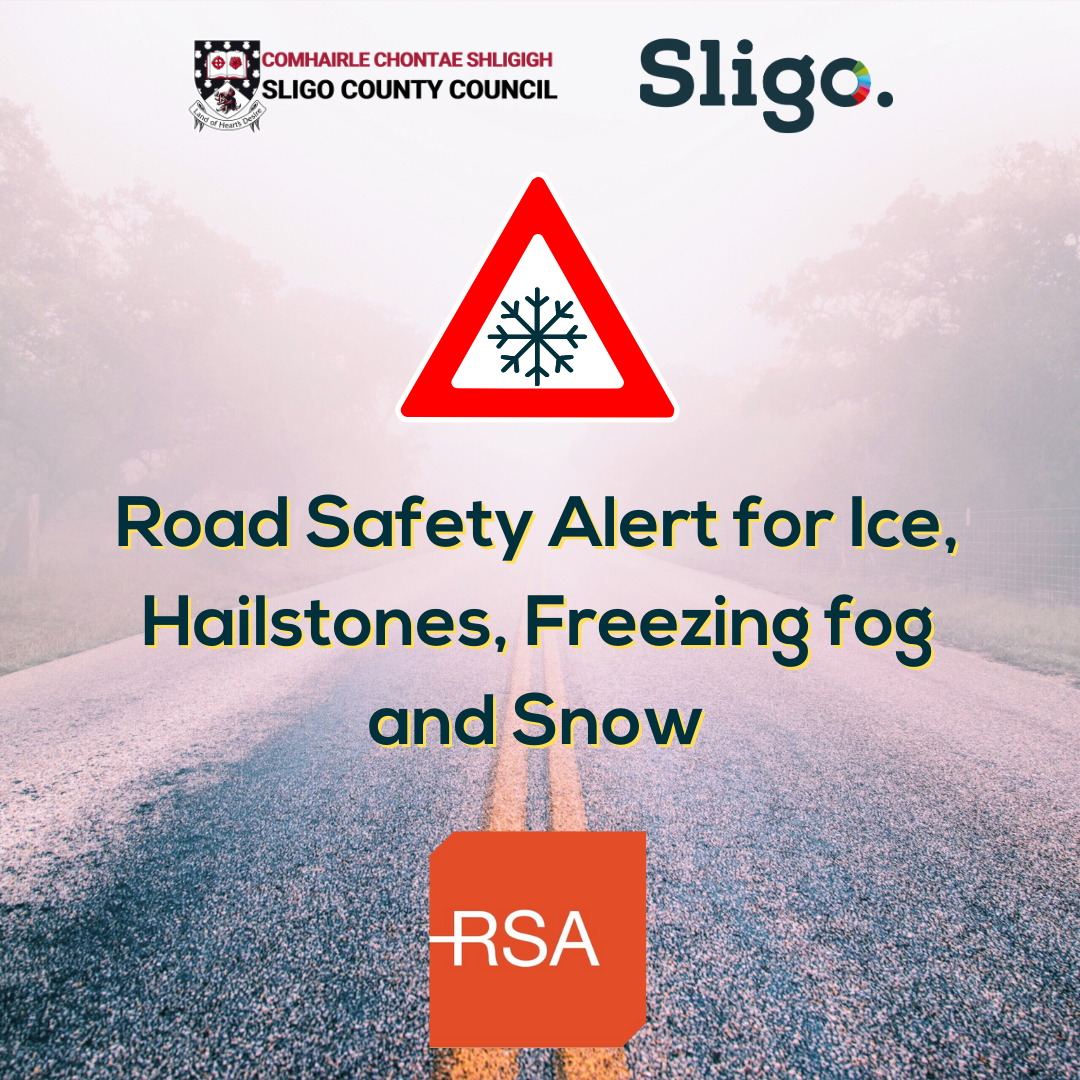The Road Safety Authority (RSA) is advising all road users to prepare for hazardous conditions on roads and footpaths this week as Met Eireann has issued an advisory for cold weather that will bring sharp to severe frosts and icy stretches on roads and footpaths.
Road Safety Alert - January 2023
Road Safety Alert for Ice, Hailstones, Freezing fog and Snow

This will include showers of hail, sleet and snow with the potential for freezing fog.
Road users should expect icy roads and be extra cautious on untreated road surfaces. Hazardous travelling conditions are expected, especially on untreated roads and footpaths.
Road users should also watch out for black ice. If the road looks polished or glossy it could be, "black ice” one of winter's worst hazards: Black Ice is difficult to see. It is nearly transparent ice that often looks like a harmless puddle or is overlooked entirely. The sheltered / shaded areas on roads, under trees and adjacent to high walls are prone to black ice.
The advice for drivers to deal with icy road conditions is.
- Clear your windows and mirrors of any ice, carry a screen scraper and de-icer.
- Remember it takes longer to stop in icy conditions. Manoeuvre gently, slow down and increase your braking distance or ‘safe space’ by leaving an extra distance between you and the vehicle in front.
- Avoid too much steering, harsh braking, and acceleration.
- Use the highest gear possible to avoid wheel spin. Select a low gear when travelling downhill especially if through bends.
- Check tyres and replace them if the tread depth falls below 3mm. Check they’re inflated to the correct tyre pressure.
- Familiarise yourself with any safety assist technology like Electronic Stability Control (ESC) or Anti-Lock Braking System (ABS) in your vehicle.
- Watch out for vulnerable road users such as pedestrians, cyclists and motorcyclists and allow extra space when overtaking them.
Met Éireann is also warning of a risk of hailstone showers, especially in the west and northern parts of the country. The difficulty with hail showers is their unpredictability and localised nature. As a hail shower tracks across the country it deposits a narrow band of ball bearing sized hailstones on the ground.
The RSA has the following advice for drivers who encounter hailstones:
- If you encounter hailstones reduce your speed, without braking if possible. Warn other drivers by using your hazard warning lights.
- Driving slowly in a high gear will help your tyres maintain grip even as your tyres move over the compacted pellets of ice.
- Accelerate and brake very gently and drive slowly on bends where loss of control is more likely. Avoid sudden steering movements or hard braking.
- Keep an eye out for road markings that may become obscured and leave plenty of distance between you and the vehicle in front.
There is also a risk of sleet and snow across the country. Drivers in these conditions are advised to:
- Remove all snow from your vehicle before commencing your journey. Snow left on the roof will become loose and can drop onto the windscreen during braking, thereby causing sudden and severe restriction to your vision. It can also fall off during your drive and cause injury to pedestrians or a reflex action by another driver.
- In snow and icy conditions, slow down. Use all controls delicately and leave extra distance between you and the vehicle in front.
- In snow or sleet conditions, visibility will be reduced. Do not drive on the taillights of the vehicle in front. In heavy snow, use your fog lights, turn off your radio and open your window, so you can hear other traffic, especially at junctions.
The changing weather conditions will also pose some challenges for pedestrians and cyclists. The advice for these road users in icy conditions is as follows.
- While walking on footpaths and in public places, or entering and exiting your car or truck, DO NOT underestimate the dangers of frost and ice.
- Each winter slips and fall accidents cause serious injuries. Even when surfaces do not look especially icy or slippery, it is very possible that a thin sheet of transparent ice or “Black Ice” is covering your pathway putting you at risk.
- Many slips and falls happen in places people regard as safe and secure, typically outside their front door on the doorstep, on the path or while getting out of the car.
- If you are out walking in icy conditions wear appropriate footwear.
- Visibility is reduced in hail, sleet, or snow so at night wear high visibility clothing or carry a torch and if you cycle make sure your bike is fitted with lights front and rear.
For advice on severe weather driving tips and weather updates, please see severe weather advice on or check out the RSA Facebook and Twitter pages.
See advice on driving in our series of Severe Weather Warning videos created in collaboration with Teresa Mannion.
For more weather updates visit Met Eireann’s website here

